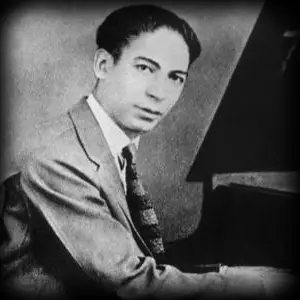JELLY ROLL MORTON
 The New Orleans pianist Jelly Roll Morton claimed to have ‘invented’ Jazz. That is a very large claim, but the egotistical Jelly Roll was not a man to down-play his own talents. While it is true that Jelly Roll was the first to publish a Jazz tune as sheet music, his assertion that Buddy Bolden played ‘ragtime’ does not hold water, at least in the eyes of his contemporaries. In the years before the First World War, the piano styles of Jazz and Blues were very closely identified, especially in the brothels of Storyville where Jelly Roll learnt his trade. The dominant style there was a strung-out ‘barrelhouse’ riffing, with a lot of space for improvisation which could be called as Jazz, but Jelly-Roll was also responsible for spreading the use of ‘walking’ left hand figures when he visited New York, where his influence laid the groundwork for the ‘stride’ piano style that became identified with that city. His recording career was very patchy, but recent Grammy winning releases testify to Jelly Roll’s huge, innovative talent.
The New Orleans pianist Jelly Roll Morton claimed to have ‘invented’ Jazz. That is a very large claim, but the egotistical Jelly Roll was not a man to down-play his own talents. While it is true that Jelly Roll was the first to publish a Jazz tune as sheet music, his assertion that Buddy Bolden played ‘ragtime’ does not hold water, at least in the eyes of his contemporaries. In the years before the First World War, the piano styles of Jazz and Blues were very closely identified, especially in the brothels of Storyville where Jelly Roll learnt his trade. The dominant style there was a strung-out ‘barrelhouse’ riffing, with a lot of space for improvisation which could be called as Jazz, but Jelly-Roll was also responsible for spreading the use of ‘walking’ left hand figures when he visited New York, where his influence laid the groundwork for the ‘stride’ piano style that became identified with that city. His recording career was very patchy, but recent Grammy winning releases testify to Jelly Roll’s huge, innovative talent.
The Jazz players of New Orleans largely played ‘by ear’ and kept their themes and variations personal by never writing them down, even though many were musically literate. When Jelly Roll published the sheet music for ‘Jelly Roll Blues’ in 1915, he broke the mould. This was indeed a first, but his claim to have “invented Jazz” was rejected by his peers, including King Oliver and his protégé, Louis Armstrong, and Buddy Bolden definitely has a better claim. Jelly Roll was certainly a larger-than-life character with a huge ego, who supplemented his income from music with pimping, gambling and all kinds of hustles. He spent some time in Canada, perhaps to avoid contact with WWI, but soon he was back in Chicago to publish some songs on piano-rolls, and then on record.
Jelly Roll remembers “…the first Blues I learnt”;
In 1923, Jelly Roll and the Red Hot Peppers, a tight band of New Orleans players, cut some stunning tracks for the Victor label in Chicago, probably his finest recorded work. A few years later, Jelly Roll had married and settled in New York, where he again recruited some stellar musicians, but none of them hung around, probably due to his difficult personality. None of his records sold very well and, after the Wall St. crash killed record sales, Jelly Roll was dropped by Victor and not picked up by anyone else. After playing in a touring vaudeville band for a while and running a bar in Washington DC, Jelly Roll was invited by Alan Lomax to record music and interviews for the Library of Congress in 1938. These had some rather suggestive contents, and were not fully released until 2005, when they won two Grammys and a Lifetime Achievement Grammy for Jelly Roll himself.
Not long afterwards, that big mouth got Jelly Roll stabbed, and botched medical care meant that he never really recovered. Despite asthma attacks, he recorded again in New York and in 1941, while in Los Angeles trying to set up a new band, he died from respiratory problems after a short spell in hospital.
